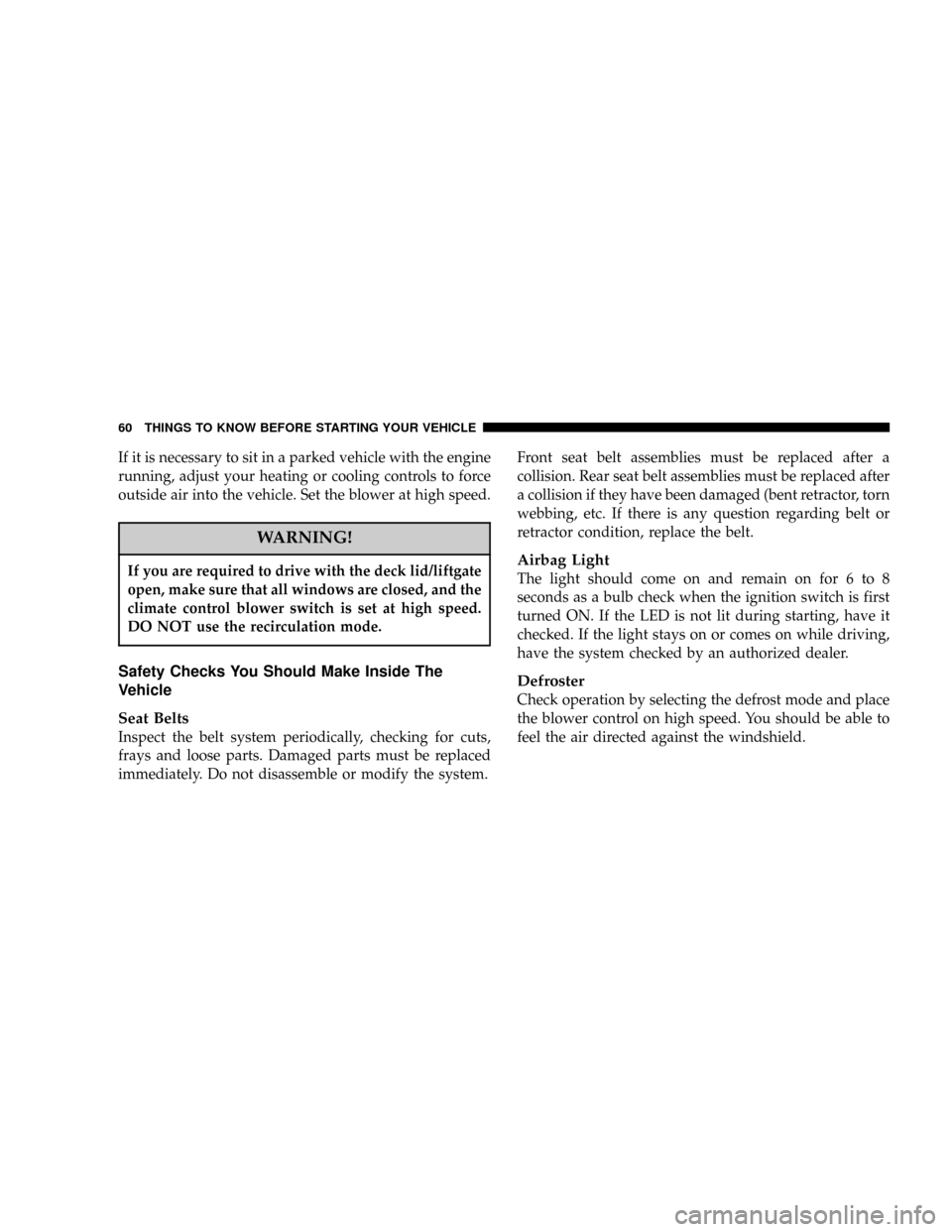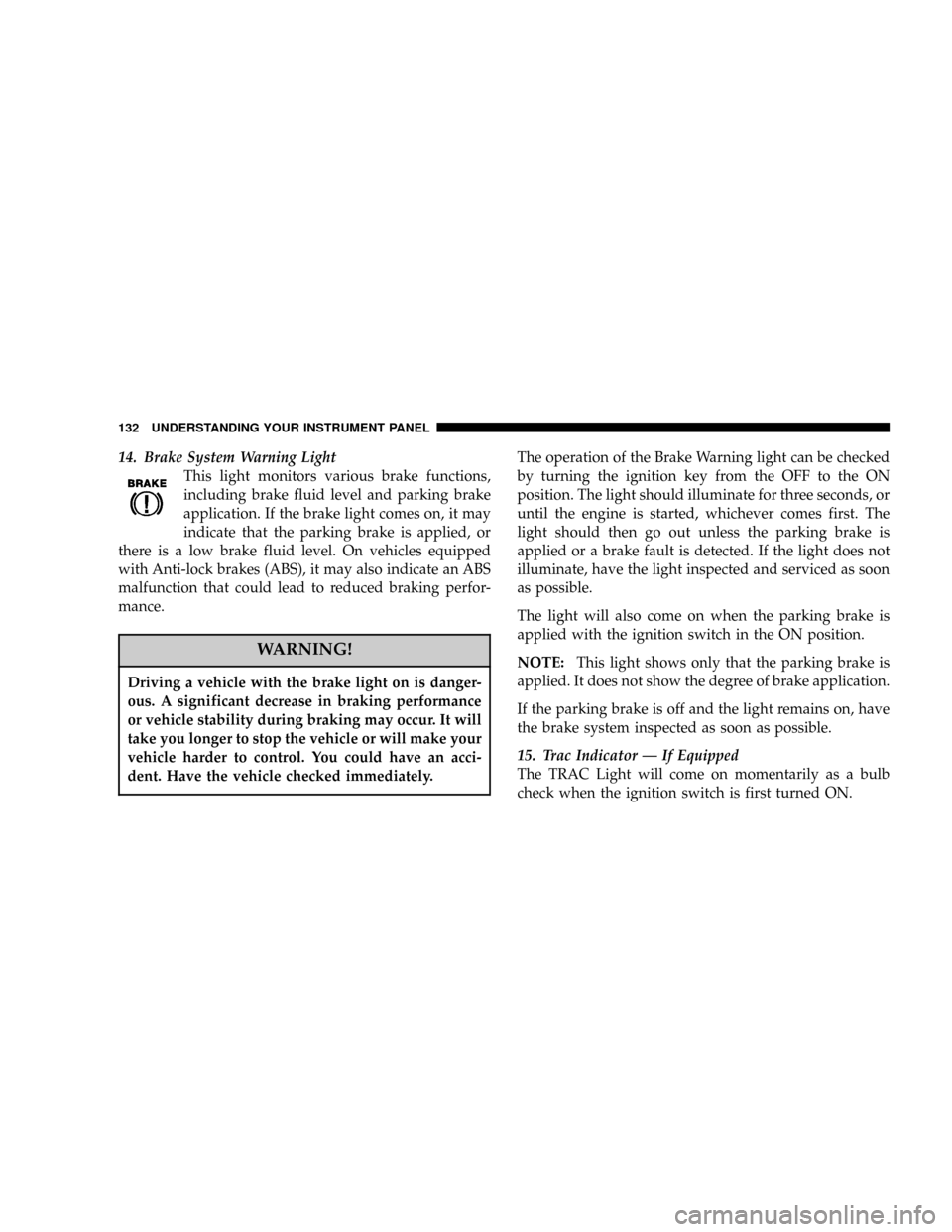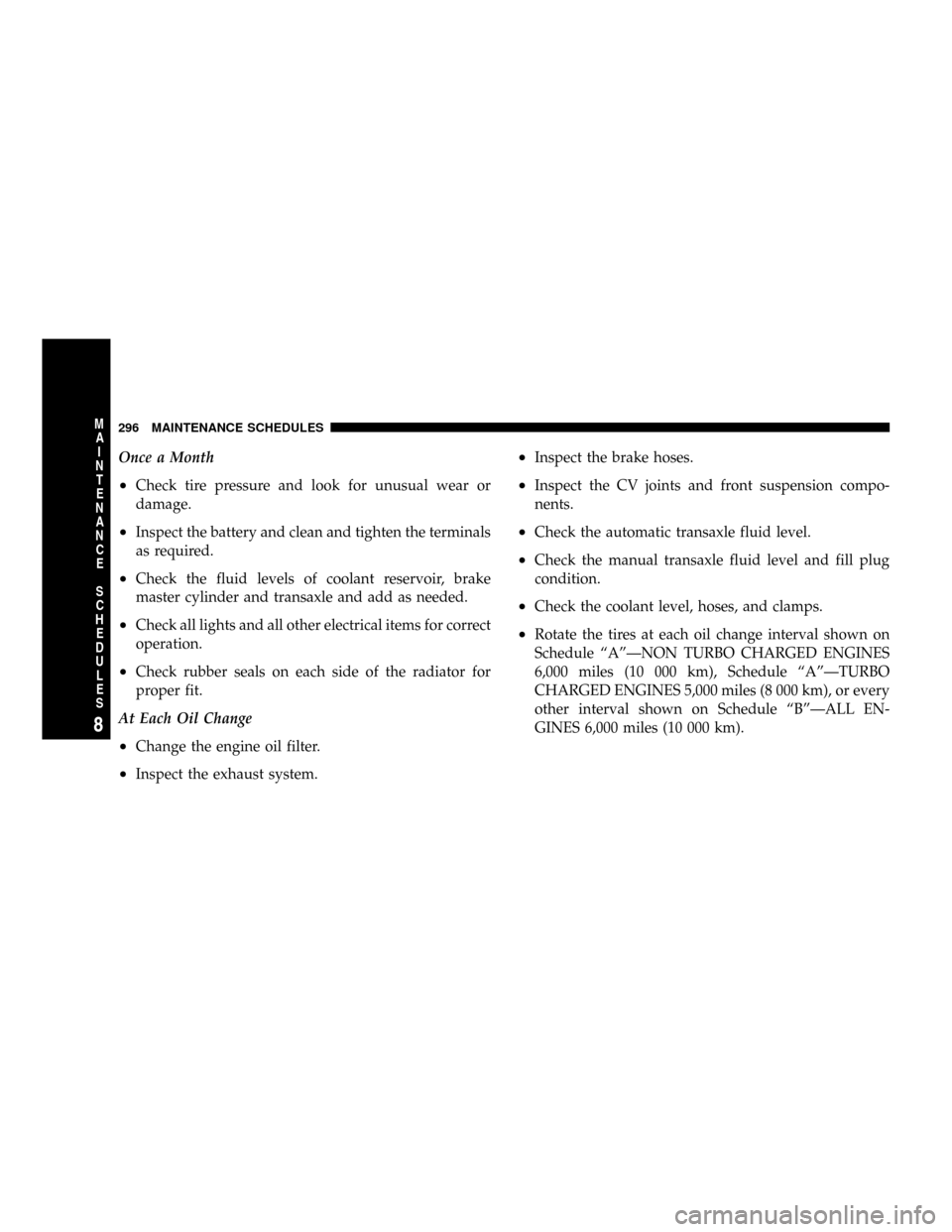check engine light CHRYSLER PT CRUISER 2004 1.G Owners Manual
[x] Cancel search | Manufacturer: CHRYSLER, Model Year: 2004, Model line: PT CRUISER, Model: CHRYSLER PT CRUISER 2004 1.GPages: 341, PDF Size: 5.06 MB
Page 15 of 341

chip (transponder) embedded into them. Only keys that
have been programmed to the vehicle can be used to start
and operate the vehicle.
The Sentry Key Immobilizer System does not need to be
armed or activated. Operation of the system is automatic
regardless of whether or not the vehicle is locked or
unlocked. During normal operation, the Theft Alarm/
Immobilizer Light will come on for three (3) seconds
immediately after the ignition switch is turned on for a
bulb check. Afterwards, if the bulb remains on, this
indicates a problem with the electronics.
If the bulb begins to flash after the bulb check, this
indicates that an invalid key has been used to start the
vehicle. Both of these conditions will result in the engine
being shut off after two (2) seconds of running.
Keep in mind that a key which has not been programmed
is also considered an invalid key even if it is cut to fit the
ignition lock cylinder for that vehicle.If the Theft Alarm/Immobilizer Light comes on during
normal vehicle operation (vehicle has been running for
longer than 10 seconds), a fault has been detected in the
electronics and the vehicle should be serviced as soon as
possible.
NOTE:
²The Sentry Key Immobilizer System is not compatible
with remote starting systems. Use of these systems
may result in vehicle starting problems and loss of
security protection.
²Exxon/Mobil Speed Pass,Ÿ additional Sentry Keys, or
any other transponder equipped components on the
same keychain willnotcause a key-related (transpon-
der) fault unless the additional part isphysically held
against the ignition keybeing used when starting the
vehicle. Cell phones, pagers, or other RF electronics
will not cause interference with this system.
THINGS TO KNOW BEFORE STARTING YOUR VEHICLE 15
2
Page 60 of 341

If it is necessary to sit in a parked vehicle with the engine
running, adjust your heating or cooling controls to force
outside air into the vehicle. Set the blower at high speed.
WARNING!
If you are required to drive with the deck lid/liftgate
open, make sure that all windows are closed, and the
climate control blower switch is set at high speed.
DO NOT use the recirculation mode.
Safety Checks You Should Make Inside The
Vehicle
Seat Belts
Inspect the belt system periodically, checking for cuts,
frays and loose parts. Damaged parts must be replaced
immediately. Do not disassemble or modify the system.Front seat belt assemblies must be replaced after a
collision. Rear seat belt assemblies must be replaced after
a collision if they have been damaged (bent retractor, torn
webbing, etc. If there is any question regarding belt or
retractor condition, replace the belt.
Airbag Light
The light should come on and remain on for 6 to 8
seconds as a bulb check when the ignition switch is first
turned ON. If the LED is not lit during starting, have it
checked. If the light stays on or comes on while driving,
have the system checked by an authorized dealer.
Defroster
Check operation by selecting the defrost mode and place
the blower control on high speed. You should be able to
feel the air directed against the windshield.
60 THINGS TO KNOW BEFORE STARTING YOUR VEHICLE
Page 61 of 341

Periodic Safety Checks You Should Make Outside
The Vehicle
Tires
Examine tires for excessive tread wear or uneven wear
patterns. Check for stones, nails, glass, or other objects
lodged in the tread. Inspect tread and sidewall for cuts or
cracks. Check wheel nuts for tightness, and tires (includ-
ing spare) for proper pressure.
Lights
Have someone observe the operation of exterior lights
while you work the controls. Check turn signal and high
beam indicator lights on the instrument panel.
Fluid Leaks
Check area under vehicle after overnight parking for fuel,
engine coolant, oil or other fluid leaks. Also, if gasoline
fumes are detected or fuel, power steering fluid or brake
fluid leaks are suspected, the cause should be located and
corrected immediately.
THINGS TO KNOW BEFORE STARTING YOUR VEHICLE 61
2
Page 129 of 341

INSTRUMENT CLUSTER DESCRIPTIONS
1. Fuel Gauge
When the ignition switch is in the ON position, the
pointer will show the level of fuel remaining in the
fuel tank.
2. Charging System Light
This light shows the status of the electrical charg-
ing system. The light should come on briefly when
the ignition is first turned ON and remain on briefly as a
bulb check. If the light stays on or comes on while
driving, it means that there is a problem with the
charging system. Obtain SERVICE IMMEDIATELY.
3. Liftgate Ajar
This light comes on if the liftgate is not com-
pletely closed.4. Oil Pressure Light
Shows low engine oil pressure. The light will come
on and remain on when the ignition switch is
turned from the OFF to the ON position, and the light
will turn off after the engine is started. If the bulb does
not come on during starting, have the system checked by
an authorized dealer.
If the light comes on and remains on while driving, stop
the vehicle and shut off the engine. DO NOT OPERATE
THE VEHICLE UNTIL THE CAUSE IS CORRECTED.
The light does not show the quantity of oil in the engine.
This can be determined using the procedure shown in
Section 7.
5. Theft Alarm Light Ð If Equipped
This light will flash rapidly for several seconds when the
alarm system is arming. The light will begin to flash
slowly indicating that the system is armed.
UNDERSTANDING YOUR INSTRUMENT PANEL 129
4
Page 131 of 341

10. High Beam Indicator
This light shows that the headlights are on high
beam. Pull the turn signal lever toward the steer-
ing wheel to switch the headlights from high or low
beam.
11. Tachometer
The white area of the scale shows the permissible engine
revolutions-per-minute (rpm x 1000) for each gear range.
Before reaching the red area, ease up on the accelerator to
prevent engine damage.
12. Anti-Lock Warning Light (ABS) Ð If Equipped
This light monitors the Anti-Lock Brake System
(ABS) described elsewhere in this manual. This
light will come on when the ignition key is
turned to the ON position and may stay on for
as long as four seconds.
If the ABS light remains on or comes on during driving,
it indicates that the Anti-Lock portion of the brake systemis not functioning and that service is required, however,
the conventional brake system will continue to operate
normally provided that the BRAKE warning light is not
on.
If the ABS light is on, the brake system should be serviced
as soon as possible to restore the benefit of Anti-Lock
Brakes.
The warning light should be checked frequently to assure
that it is operating properly. Turn the ignition key to the
on position, but do not start the vehicle. The light should
come on. If the light does not come on, have the system
checked by an authorized dealer.
13. Seat Belt Reminder Light
When the ignition switch is first turned ON, this
light will come on for about six seconds. A chime
will sound if you have not pulled the shoulder belt
out of the retractor. This is a reminder to ªbuckle upº. If
you do not buckle up, the light will remain on.
UNDERSTANDING YOUR INSTRUMENT PANEL 131
4
Page 132 of 341

14. Brake System Warning Light
This light monitors various brake functions,
including brake fluid level and parking brake
application. If the brake light comes on, it may
indicate that the parking brake is applied, or
there is a low brake fluid level. On vehicles equipped
with Anti-lock brakes (ABS), it may also indicate an ABS
malfunction that could lead to reduced braking perfor-
mance.
WARNING!
Driving a vehicle with the brake light on is danger-
ous. A significant decrease in braking performance
or vehicle stability during braking may occur. It will
take you longer to stop the vehicle or will make your
vehicle harder to control. You could have an acci-
dent. Have the vehicle checked immediately.
The operation of the Brake Warning light can be checked
by turning the ignition key from the OFF to the ON
position. The light should illuminate for three seconds, or
until the engine is started, whichever comes first. The
light should then go out unless the parking brake is
applied or a brake fault is detected. If the light does not
illuminate, have the light inspected and serviced as soon
as possible.
The light will also come on when the parking brake is
applied with the ignition switch in the ON position.
NOTE:This light shows only that the parking brake is
applied. It does not show the degree of brake application.
If the parking brake is off and the light remains on, have
the brake system inspected as soon as possible.
15. Trac Indicator Ð If Equipped
The TRAC Light will come on momentarily as a bulb
check when the ignition switch is first turned ON.
132 UNDERSTANDING YOUR INSTRUMENT PANEL
Page 134 of 341

20. Airbag Light
The light comes on and remains on for 6 to 8
seconds as a bulb check when the ignition switch
is first turned ON. If the light does not come on
during starting, stays on, or comes on while driving, have
the system checked by an authorized dealer.
21. Trac Off Light Ð If Equipped
The TRAC OFF light will illuminate momentarily as a
bulb check when the ignition switch is first turned ON. If
the light does not come on, have the system checked.
The light will also come on if:
²The Traction Control switch has been used to turn
the system off,
²There is an anti-lock system failure,
²There is a Traction Control system failure,
²The system has been automatically deactivated to
prevent damage to the brake system due to over-
heated brake temperatures.
NOTE:Extended heavy use of Traction Control may
cause the system to deactivate and turn on the TRAC
OFF Light. This is to prevent overheating of the brake
system and is a normal condition. The system will remain
disabled for about 4 minutes until the brakes have
cooled. The system will automatically reactivate and turn
off the TRAC OFF Light.
22. Malfunction Indicator Light
This light is part of an onboard diagnostic system
called OBD that monitors emissions, engine, and
automatic transmission control systems. The light
will illuminate when the key is in the ON/RUN position
before engine start. If the bulb does not come on when
turning the key from OFF to ON/RUN, have the condi-
tion checked promptly.
134 UNDERSTANDING YOUR INSTRUMENT PANEL
Page 296 of 341

Once a Month
²Check tire pressure and look for unusual wear or
damage.
²Inspect the battery and clean and tighten the terminals
as required.
²Check the fluid levels of coolant reservoir, brake
master cylinder and transaxle and add as needed.
²Check all lights and all other electrical items for correct
operation.
²Check rubber seals on each side of the radiator for
proper fit.
At Each Oil Change
²Change the engine oil filter.
²Inspect the exhaust system.
²Inspect the brake hoses.
²Inspect the CV joints and front suspension compo-
nents.
²Check the automatic transaxle fluid level.
²Check the manual transaxle fluid level and fill plug
condition.
²Check the coolant level, hoses, and clamps.
²Rotate the tires at each oil change interval shown on
Schedule ªAºÐNON TURBO CHARGED ENGINES
6,000 miles (10 000 km), Schedule ªAºÐTURBO
CHARGED ENGINES 5,000 miles (8 000 km), or every
other interval shown on Schedule ªBºÐALL EN-
GINES 6,000 miles (10 000 km).
296 MAINTENANCE SCHEDULES
8
M
A
I
N
T
E
N
A
N
C
E
S
C
H
E
D
U
L
E
S
Page 326 of 341

ABS (Anti-Lock Brake) System.............. 194
Adding Engine Coolant (Antifreeze).......... 267
Adding Fuel........................... 221
Adding Washer Fluid..................... 175
Additives, Fuel......................... 219
Air Cleaner, Engine...................... 258
Air Conditioning........................ 261
Air Conditioning Controls................. 166
Air Conditioning, Operating Tips............ 171
Air Conditioning Refrigerant............... 261
Air Conditioning System................166,261
Air Pressure, Tires....................... 207
Airbag................................ 41
Airbag Deployment....................... 48
Airbag Light.....................45,50,60,134
Airbag Maintenance....................... 49
Airbag, Side............................ 47
Alarm, Panic............................ 23
Alarm System........................26,129Alignment and Balance................... 213
Alterations/Modifications, Vehicle............. 7
Antenna, Satellite Radio................... 164
Antifreeze (Engine Coolant)...........267,290,291
Capacities........................... 290
Anti-Lock Brake System................... 194
Anti-Lock Warning Light.................. 131
Anti-Theft Security Alarm.................. 26
Appearance Care........................ 276
Auto Down Power Windows................ 31
Automatic Door Locks..................... 20
Automatic Transaxle..............12,180,183,273
Fluid and Filter Changes................. 275
Fluid Level Check...................273,274
Interlock System.....................18,184
Reset Mode.......................... 184
Selection Of Lubricant................... 273
Shifting............................. 185
Special Additives...................... 276
326 INDEX
Page 329 of 341

Radiator Cap......................... 267
Selection of Coolant.................... 267
Corrosion Protection..................... 276
Crankcase Emission Control System.......... 258
Cruise Light........................... 133
Cup Holder............................ 112
Customer Assistance..................... 316
Dealer Service.......................... 250
Defroster, Rear Window................... 173
Defroster, Windshield................60,168,169
Delay Wipers........................... 99
Diagnostic System, Onboard................ 248
Dimmer Switch, Headlight.................. 97
Disposal
Engine Oil........................... 255
Door Ajar............................. 133
Door Locks............................. 18
Door Locks, Automatic.................... 20Downshifting.......................... 191
Drive Belts............................ 256
Driving
On Slippery Surfaces.................... 238
Electric Rear Window Defrost............... 173
Electric Remote Mirrors.................... 68
Electrical Power Outlets................... 110
Electronic Power Distribution Center.......... 282
Electronic Speed Control................... 101
Emergency, In Case of
Jacking............................. 230
Jump Starting......................... 235
Towing............................. 240
Emergency Trunk Release................... 29
Emission Control System Maintenance......249,294
Engine............................246,247
Break-In Recommendations................ 59
Checking Oil Level..................... 251
INDEX 329
10